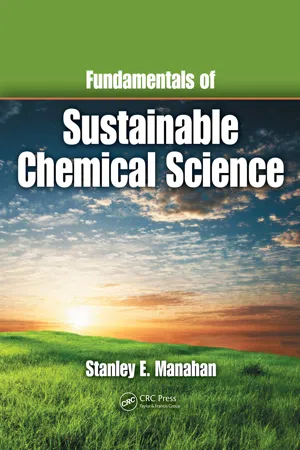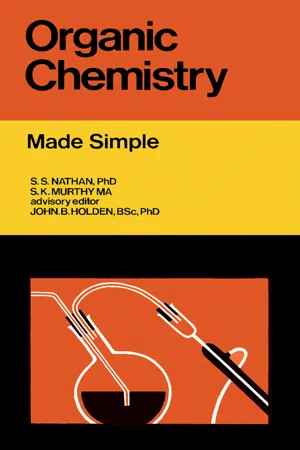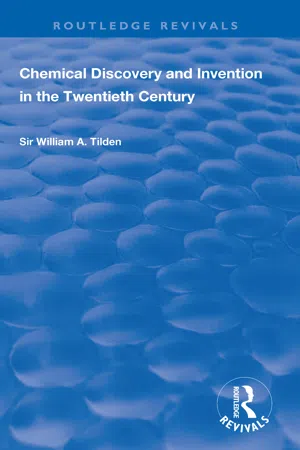Chemistry
Anthracene
Anthracene is a polycyclic aromatic hydrocarbon consisting of three fused benzene rings. It is a solid, colorless compound with a distinct blue fluorescence when exposed to ultraviolet light. Anthracene is used in the production of dyes, as a starting material for the synthesis of various organic compounds, and in research as a fluorescent tracer.
Written by Perlego with AI-assistance
Related key terms
1 of 5
5 Key excerpts on "Anthracene"
- eBook - PDF
- Stanley E. Manahan(Author)
- 2009(Publication Date)
- CRC Press(Publisher)
As shown in Figure 9.8, some arenes, such as naphthalene and the polycyclic aromatic compound benzo[ and the polycyclic aromatic compound benzo[ a ]pyrene, contain fused rings. ]pyrene, contain fused rings. OH OH Cl 1 2 3 4 5 6 Naphthalene Phenol No H atoms 1 H atom Ortho Para Meta Benzo(a)pyrene 3-Chlorophenol or meta -chlorophenol Figure 9.8. Figure 9.8. Aromatic compounds containing fused rings (top) and showing the numbering of Aromatic compounds containing fused rings (top) and showing the numbering of carbon atoms for purposes of nomenclature. carbon atoms for purposes of nomenclature. 318 Fundamentals of Sustainable Chemical Science 318 Fundamentals of Sustainable Chemical Science Benzene and Naphthalene Benzene and Naphthalene Benzene is a volatile, colorless, highly flammable liquid used to manufacture Benzene is a volatile, colorless, highly flammable liquid used to manufacture phenolic and polyester resins, polystyrene plastics, alkylbenzene surfactants, chloro-phenolic and polyester resins, polystyrene plastics, alkylbenzene surfactants, chloro-benzenes, insecticides, and dyes. It is hazardous both for its ignitability and for benzenes, insecticides, and dyes. It is hazardous both for its ignitability and for its toxicity (exposure to benzene causes blood abnormalities that may develop into its toxicity (exposure to benzene causes blood abnormalities that may develop into leukemia). Naphthalene is the simplest member of a large number of polycyclic aro-leukemia). Naphthalene is the simplest member of a large number of polycyclic aro-matic hydrocarbons having two or more fused rings. It is a volatile white crystalline matic hydrocarbons having two or more fused rings. It is a volatile white crystalline solid with a characteristic odor and has been used to make mothballs. The most solid with a characteristic odor and has been used to make mothballs. - eBook - PDF
Organic Chemistry
Made Simple
- S. K. Murthy, S. S. Nathan(Authors)
- 2013(Publication Date)
- Made Simple(Publisher)
The synthesis of Anthracene from 0-bromobenzyl bromide lends support to the structure of the com- Benzene and its Derivatives 199 pound as a condensed linear system of three benzene rings, as shown below: rv CH * + Y^fVY^i-suAVt / B r B r H 2 c / V V y / ' Υ Υ τ o-Bromobenzyl H H bromide Anthracene is considered to be a resonance hybrid of the following structures. Of these, (III) and (IV) contain two truly aromatic benzene rings each, in contrast to (I) and (II), which contain only one such ring, and hence contribute predominantly to the resonance hybrid. ^/V / w ^ sy%/%, /v/% < —HI < —H I! < —► vvv v w %//s v w (I) (ID (HI) (IV) Since all three rings do not simultaneously have a conjugated system of single and double bonds, Anthracene exhibits a certain degree of aliphatic character. The 9 and 10 positions in the Anthracene molecule, referred to as meso positions, are the usual points of attack during such reactions as halogenation, oxidation, and reduction. Nitration and sulphonation, however, give mixtures of subsitituted Anthracenes. Oxidation of anthra-cene gives anthraquinone and reduction gives 9,10-dihydroAnthracene. ? H 1 II II I I Y II I ■v/^ v w ö H H Anthraquinone 9,10-DihydroAnthracene Anthraquinone is important because of its relationship to alizarin and other naturally occurring dyes, on the one hand, and to the purgative principles of cascara, rhubarb, aloes, etc., which are glycosides of hydroxy derivatives of anthraquinone. Phenanthrene (CMHIO). This hydrocarbon is isomeric with Anthracene and occurs along with it in coal tar. It has the following structure: < Λΐ f fY % ( The three benzene rings in phenanthrene are truly aromatic as compared with Anthracene, and hence phenanthrene is more stable and less reactive. For instance, phenanthrene from coal tar is easily freed from contaminated Anthracene by selective oxidation of the latter to the quinone. The usual aromatic substitution reactions proceed poorly - Isadore Berlman(Author)
- 2012(Publication Date)
- Academic Press(Publisher)
Tetracene is a symmetrical compound with well-defined spectra characteristic of a l A-l L a transition. Its spectra are positioned at wave-lengths about 1000 A longer than those of the spectra from Anthracene. The 80 4. COMPOUNDS fluorescence quantum yield is greatly enhanced by substitution of phenyl rings in the 5, 6, 11, and 12 positions as in rubrene. 2. Bent Systems. Phenanthrene is the first member of the bent system of catacondensed compounds. Its chemical formula, Ci 4 Hi 0 , is the same as that of Anthracene and structurally it can be considered either as a vinyl-bridged biphenyl or as 1,2-benzonaphthalene. Spectroscopically the fluorescence characteristics of phenanthrene resemble those of a beta-sub-stituted naphthalene. Thus 1,2-benzonaphthalene is an appropriate name for this compound. The long wavelength absorption bands are produced by a 1 A-1 Lb transition and this transition is polarized parallel to the symmetry axis of the molecule. 104 NMR measurements 190 have been made to demonstrate that there is some interference between the hydrogen atoms in the 4 and 5 positions of phenanthrene. By means of x-ray techniques it has been shown that larger and more bent compounds such as 3,4-benzophenanthrene 191 and 3,4;5,6-dibenzophenanthrene 192 experience an even greater amount of crowding. As an aside, it might be mentioned that this type of intra-molecular crowding leads to the interesting phenomenon of optical activity. 193 Spectroscopically the reduced structure in the spectra of the latter two compounds is indicative of the fact that they are nonplanar. In analogues of the above compounds such as benzo[0/w]fluoranthene (#193C) and benzo(0iW)perylene (#198B) the steric hindrance is somewhat relieved by bridging and well-defined spectra and larger values of e max are observed. Chrysene (#181C) is another member of the bent hydrocarbons. Its fluorescence characteristics resemble those of a substituted phenanthrene or beta-substituted naphthalene.- eBook - ePub
Conjugated Objects
Developments, Synthesis, and Applications
- Atsushi Nagai, Koji Takagi, Atsushi Nagai, Koji Takagi(Authors)
- 2017(Publication Date)
- Jenny Stanford Publishing(Publisher)
Chapter 2Fused Polycyclic Aromatic Compounds: [njAcenes, [njHelicenes, and Their Heterocyclic Analogues
Koji NakanoDepartment of Organic and Polymer Materials Chemistry, Tokyo University of Agriculture and Technology, 2-24-16 Naka-cho, Koganei, Tokyo 184-8588, Japan [email protected]Polycyclic aromatic compounds, such as [n ]acenes, [n ]helicenes, and their heterocyclic analogues, have been widely studied because of their attractive function such as semiconducting, emission, and chiroptical properties. To create new functional materials based on these classes of p-conjugated compounds, the development of efficient synthetic method is indispensable. This chapter will briefly survey [n ]acenes, [n ]helicenes, and their heterocyclic analogues mainly from the viewpoint of synthetic methods.2.1 IntroductionFused π-conjugated compounds have attracted much attention because of their optical and electronic properties, which allow them to be applicable to organic field-effect transistors (OFETs),1 organic light-emitting diodes (OLEDs),2 and organic photovoltaics (OPVs).3 Their properties depend on many factors such as the number of fused rings, a connectivity of aromatic rings, the incorporated elements, and so on. Therefore, a numerous number of fused π-conjugated compounds have been synthesized and characterized to study structure-property relationship and to develop high-performance functional materials.The basic component of fused π-conjugated compounds is the benzene ring. The fusion of two benzene rings results in naphthalene where two carbon atoms and one C-C bond are shared (ortho -fused) (Fig. 2.1 ). The fusion of three benzene rings gives two isomers, depending on their connectivity. One is Anthracene, which consists of three ortho -fused benzene rings in a linear arrangement. Another is phenanthrene, in which naphthalene is fused with a benzene ring at the C1-C2 bond to form a bent structure. Further annelation of benzene ring(s) to Anthracene in a linear manner gives the so-called [n jacenes such as tetracene and pentacene. A zigzag annelation of benzene ring(s) to phenanthrene affords [n jphenacenes such as chrysene and picene. These [n jacenes and [n jphenacenes possess planar structures and demonstrate promising properties as organic semiconductors for OFETs. On the other hand, an angular annelation of benzene ring(s) to phenanthrene gives [n jhelicenes with nonplanar helical structures. [n - Wiliam A. Tilden(Author)
- 2018(Publication Date)
- Routledge(Publisher)
10 , which occurs among the least volatile portions of coal-tar, and up to this time it had been totally neglected and left in the pitch. Its relation to Anthracene being once known a key was obtained to its constitution, and in 1869 patents were taken out for its production by Caro, Graebe, and Liebermann, followed only one day later by W. II. Perkin.This was the first natural colouring matter to be produced synthetically and one of the most important, inasmuch as alizarin and its derivatives and associates are employed in the production of cotton prints all over the world, and are capable of giving a great variety of colours. Here it must be explained that alizarin and the allied colouring matter purpurine are often referred to as adjective dyes, because they do not dye either animal or vegetable fibre without previously impregnating the fibre with some basic substance, such as alumina or oxide of iron, chromium, or some other metal. The colouring matter unites with such substances forming chemical compounds called lakes which are insoluble in water. The metallic base introduced is called a mordant , and each colouring matter produces a different colour on the cloth by varying the mordant. Thus alizarin withDyes which attach themselves directly to the fibre are spoken of as substantive dyes.A large amount of knowledge has been gained in recent times as to the chemical constitution of the substances of which wool and silk fibres are composed, and the facts have given much assistance toward the conception of a comprehensive theory of dyeing. For reasons to be explained later no one theory has yet been completely established, and much remains in obscurity.
Index pages curate the most relevant extracts from our library of academic textbooks. They’ve been created using an in-house natural language model (NLM), each adding context and meaning to key research topics.




